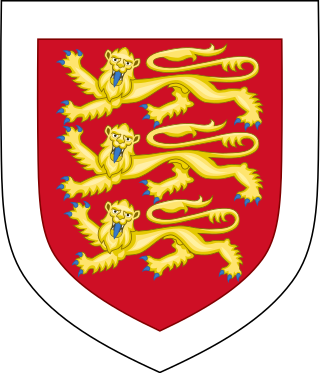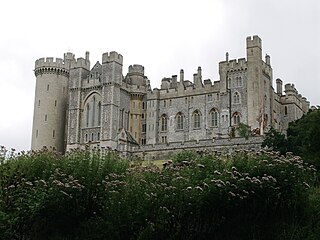
Margaret Holland was a medieval English noblewoman. She was a daughter of Thomas Holland, 2nd Earl of Kent, who was the son of Joan "the Fair Maid of Kent". Margaret's mother was Alice FitzAlan, daughter of Richard FitzAlan, 10th Earl of Arundel and Eleanor of Lancaster.

Edmund Mortimer, 5th Earl of March, 7th Earl of Ulster, was an English nobleman and a potential claimant to the throne of England. A great-great-grandson of King Edward III of England, he was heir presumptive to King Richard II of England when he was deposed in favour of Henry IV. Edmund Mortimer's claim to the throne was the basis of rebellions and plots against Henry IV and his son Henry V, and was later taken up by the House of York in the Wars of the Roses, though Mortimer himself was an important and loyal vassal of Henry V and Henry VI. Edmund was the last Earl of March of the Mortimer family.

John Holland, 2nd Duke of Exeter, 2nd Earl of Huntingdon, was an English nobleman and military commander during the Hundred Years' War. His father, the 1st Duke of Exeter, was a maternal half-brother to Richard II of England, and was executed after King Richard's deposition. The Holland family estates and titles were forfeited, but John was able to recover them by dedicating his career to royal service. Earl of Huntingdon, of the Castle, town, manor of Barnstable and manors of Dartington, Fremington, South Molton, Torrington, Devon, Stevington, Bedfordshire, Ardington, Berkshire, Haslebury, Blagdon and Somerset. Holland rendered great assistance to his cousin Henry V in his conquest of France, fighting both on land and on the sea. He was marshal and admiral of England and governor of Aquitaine under Henry VI.

Thomas Holland, 2nd Earl of Kent was an English nobleman and a councillor of his half-brother, King Richard II of England.

Thomas Holland, 1st Duke of Surrey, 3rd Earl of Kent, KG, Earl Marshal was an English nobleman and courtier.
The peerage title Earl of Kent has been created eight times in the Peerage of England and once in the Peerage of the United Kingdom. In fiction, the Earl of Kent is also known as a prominent supporting character in William Shakespeare's tragedy King Lear.

Roger de Mortimer, 4th Earl of March, 6th Earl of Ulster was an English nobleman. He was considered the heir presumptive to King Richard II, his mother's first cousin, as being a great-grandson of King Edward III.

Edmund Grey, 1st Earl of Kent, KB, English administrator, nobleman and magnate, was the son of Sir John Grey, KG and Constance Holland. His main residence was at Wrest near Silsoe, Bedfordshire.
Constance of York, Countess of Gloucester was the only daughter of Edmund of Langley, 1st Duke of York, and his wife Isabella of Castile, daughter of King Peter of Castile and his favourite mistress, María de Padilla.

Henry Scrope, 3rd Baron Scrope of Masham KG, also known in older sources as Lord Scrope was a favourite of Henry V, who performed many diplomatic missions. He was beheaded for his involvement in the notional Southampton Plot to assassinate the king. Some historians believe that the charge was trumped-up to punish him for other acts of disloyalty, and that there may never have been such a plot.

Baron Wake of Liddell is an abeyant title in the Peerage of England. It was created in 1295 for John Wake. It has been in abeyance since 1408.

Isabella of Castile, Duchess of York was the daughter of King Peter and his mistress María de Padilla. She accompanied her elder sister, Constance, to England after Constance's marriage to John of Gaunt, 1st Duke of Lancaster, and married Gaunt's younger brother, Edmund of Langley, 1st Duke of York.
Joan Holland was the third daughter of Thomas Holland, 2nd Earl of Kent, and Alice FitzAlan. She married four times. Her first husband was a duke, and the following three were barons. All of her marriages were most likely childless.
Events from the 1400s in England.

Richard de Vere, 11th Earl of OxfordKG was the son and heir of Aubrey de Vere, 10th Earl of Oxford. He took part in the trial of Richard, Earl of Cambridge, and Lord Scrope for their part in the Southampton Plot, and was one of the commanders at Agincourt in 1415.

Lady Alice Holland, Countess of Kent, LG, formerly Alice FitzAlan, was an English noblewoman, a daughter of the 10th Earl of Arundel, and the wife of the 2nd Earl of Kent, the half-brother of King Richard II. As the maternal grandmother of Anne de Mortimer, she was an ancestor of kings Edward IV and Richard III, as well as King Henry VII and the Tudor dynasty through her daughter Margaret Holland. She was also the maternal grandmother of Joan Beaufort, Queen of Scots.

Alianore Holland, Countess of March was the eldest daughter of Thomas Holland, 2nd Earl of Kent, and the wife of Roger Mortimer, 4th Earl of March, heir presumptive to her uncle, King Richard II. Through her daughter, Anne Mortimer, she was the great-grandmother of the Yorkist kings Edward IV and Richard III. She was governess to Richard II's wife, Isabella of Valois.

Eleanor Holland, Countess of Salisbury, was an English noblewoman, the daughter of Thomas Holland, 2nd Earl of Kent, a half-brother of King Richard II of England. She was the first wife of Thomas Montagu, 4th Earl of Salisbury. One of her brothers was Edmund Holland, 4th Earl of Kent, to whom she was co-heiress. She is not to be confused with her eldest sister Alianore Holland, Countess of March who bore the same name.
Lucia Visconti was a Milanese aristocrat who was the Countess of Kent by marriage from 1407 to 1424. She was one of fifteen legitimate children of Bernabò Visconti, who, along with his brother Galeazzo, was Lord of Milan. Her father negotiated for his infant daughter to marry Louis II of Anjou but Bernabò was deposed and the negotiations dropped. As a teenager, it was then intended that she marry the English noble Henry Bolingbroke, whom she had met as a girl, but after he was banished to France, the marriage negotiations were suspended. She was briefly wedded in 1399 to Frederick IV of Thuringia, the son of Landgrave Balthasar, before the marriage was annulled.

The Holland family was a medieval-era English noble family. Many Hollands were Dukes, Earls, Knights and Barons in medieval England, and they played significant roles in the struggles for the crown in the fourteenth and fifteenth century.












